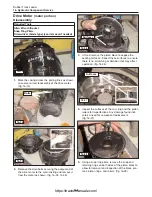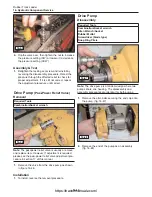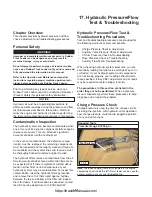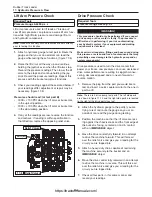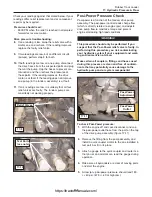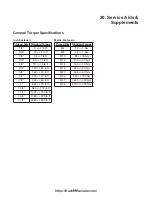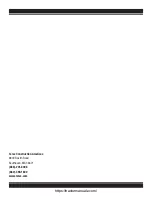
Lift Arm Pressure Check
Lift arm pressure is used to lift loads or “break-out”.
Low lift arm pressure can produce a weak lift arm func-
tion while high lift arm pressure can damage lift arm
and hydraulic components.
Note:
Make sure auxiliary circuit pressures are set correctly
prior to testing this function.
1.
Attach a hydraulic gauge to test port B. Route the
gauge so that you or an assistant can read the
gauge while testing these functions. (figure 17-6)
2.
Raise the lift arms all the way up and continue
holding the joystick even when the lift arms stop.
Record the pressure readings. Then lower the lift
arms to the stops and continue holding the joy-
stick. Record the pressure readings. Repeat this
process with the bucket dump/curl functions.
3.
Check your readings against those stated below. If
your readings differ, adjustment or repair may be
necessary. (figure 17-8)
Pressures should read: (at test port B)
•
3000 +/- 100 PSI when the lift arms or bucket are
in the up/curl position.
•
3000 +/- 100 PSI when the lift arms or bucket are
in the down/dump position.
4.
If any of the readings are low, reverse the function
and recheck. If reading is within specification in
that direction, replace the opposing relief valve.
Drive Pressure Check
This procedure should only be performed if you suspect
a drive pump or drive motor is faulty. The procedure is
difficult and in performing it, you risk contaminating
your hydraulic system if your equipment and working
environment is not clean.
Make certain all couplers, fittings and hoses used during
this process are clean and free of contaminants that may
potentially cause damage to the hydraulic pump and or
system components!
Drive pressure is used to turn the drive motors that
power your tracks. Low pressure can cause decreased
drive motor performance resulting in sluggish maneu-
vering, decreased speed and or uneven forward or
reverse motion.
1.
Remove the plug from the port you would like to
test and insert a quick coupler similar to the one in
port A or B.
Note:
There are 4 drive pump test ports. The left side ports
are shown in figure 17-10 and the right side ports are located
to the right of the drive ports they test.
2.
Attach the hydraulic gauge to the port(s) you are
trying to test and route the gauge so you or an
assistant can read the gauge during testing.
3.
Position the machine so that the lift arms are rest-
ing against the chassis stops and the front edge of
the bucket is facing, centered on and in contact
with an
IMMOVABLE
object.
4.
Move the drive control fully forward in an attempt
to drive the machine forward. This will force oil
over the relief valve and give you a reading for the
circuit you are tapped into.
5.
Attach a heavy-duty chain capable of restraining
the machine securely to the bucket and an
IMMOVABLE
object.
6.
Move the drive control fully rearward in an attempt
to drive the machine in reverse. This will force oil
over the relief valve and give you a reading for the
circuit you are tapped into.
7.
Check all four ports in this same manner and
record your readings.
Required Tools
Pressure Gauge 0-6000 p.s.i.
!WARNING!
17-4
Rubber Track Loader
17. Hydraulic Pressure & Flow
Required Tools
Pressure Gauge 0-6000 p.s.i.
17-8
Port (B)
Relief Valves
Relief Valves
https://tractormanualz.com/
Summary of Contents for ASV SR70
Page 5: ...IV https tractormanualz com...
Page 11: ...1 6 https tractormanualz com...
Page 41: ...4 20 https tractormanualz com...
Page 87: ...12 8 https tractormanualz com...
Page 105: ...14 6 https tractormanualz com...
Page 109: ...15 4 https tractormanualz com...
Page 125: ...16 16 https tractormanualz com...
Page 133: ...17 8 https tractormanualz com...
Page 137: ...18 4 https tractormanualz com...
Page 139: ...19 2 https tractormanualz com...



